In our previous article, we laid the foundation for your marketplace journey, talking about how to choose the right niche, define your target audience, and build a monetization strategy that makes sense. We also explored the power of having a strong co-founder and a business plan that does more than just sit in a drawer.
Now, it’s time to move from planning to building.
This guide dives into the next big question: how do you actually launch an online marketplace that people want to use, and come back to?
We’ll walk you through the key stages of development: defining must-have features, choosing the right tech approach, and working with a team that shares your vision. You’ll also learn how to earn user trust, promote your platform, and grow with purpose.
Want to launch a marketplace that rises above the online crowd? You’re in the right spot, let’s make your idea thrive.
1. Define the functionality
Let’s start with the basic features any online marketplace should have. These functions will make your e-commerce website convenient for both parties.
Stunning product pages
Each product deserves its own spotlight: high-resolution images, engaging videos and benefit-driven copy help buyers visualize the value. Detailed descriptions and specifications build trust by answering questions before they’re asked.
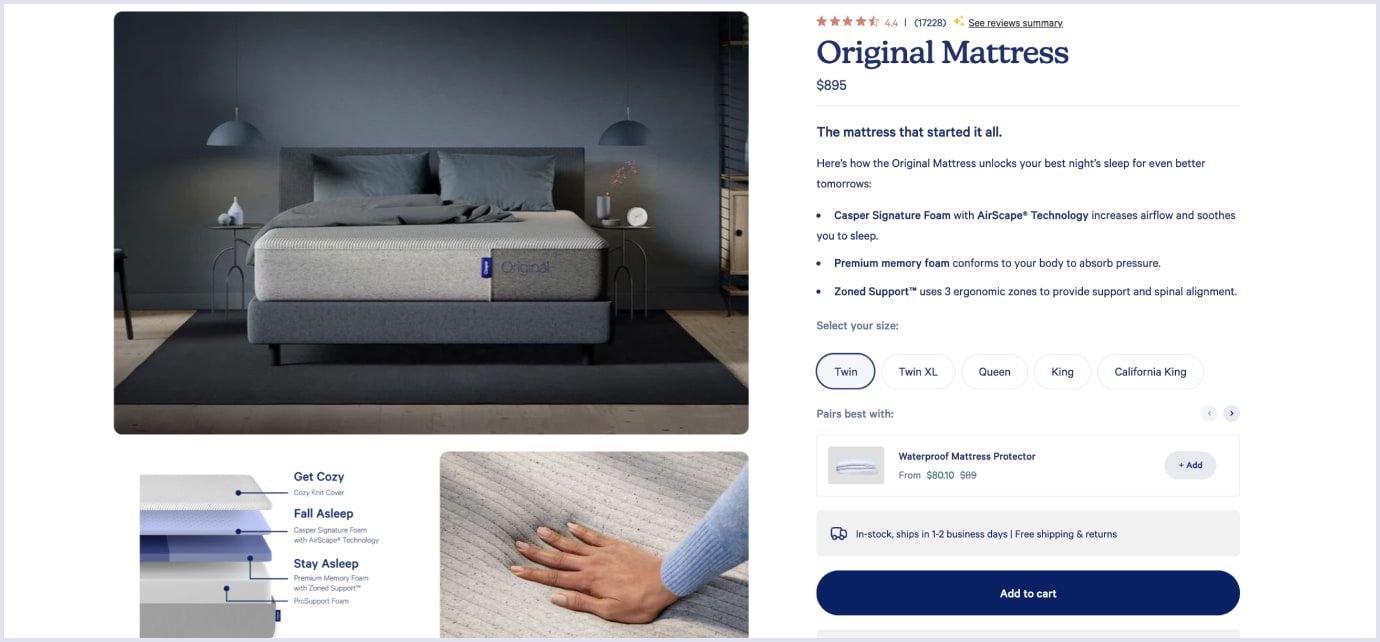
Source: Casper
Seamless shopping cart
A frictionless cart experience means fewer abandoned sessions and more completed orders. Allow users to add, update or remove items with a single click, and display real-time totals so there are no surprises at checkout.
Rock-solid security
Protecting user data isn’t optional, it’s your reputation at stake. Implement SSL certificates, two-factor authentication and enterprise-grade firewalls to safeguard every interaction on your platform.
Multiple payment options
Cater to diverse preferences by integrating top gateways like PayPal, Stripe, Braintree or WePay. Offering various payment methods reduces cart drop-off and increases conversions by letting customers pay the way they trust.
Read also: 11 Best Payment Solutions for Online Marketplaces in 2025
Smart search & filters
When your catalog grows, a prominent search bar and intuitive filters become indispensable. Place the search field in a familiar spot (top corners work best) and let users narrow results by category, price or other key attributes.
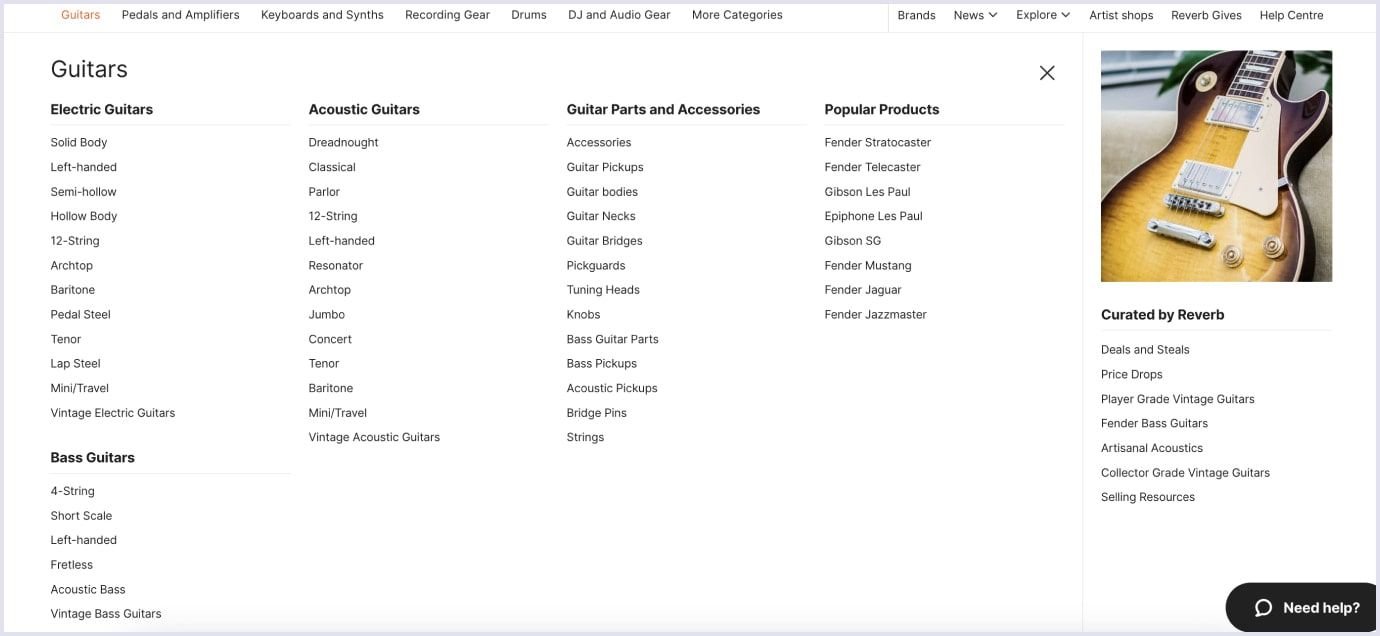
Source: Reverb
Personalized wishlists
Wishlists turn one-time visitors into repeat buyers by giving them a place to save favorites. Enable shoppers to curate collections, get reminders and jump straight to the products they love when they’re ready to purchase.
Effortless registration & profiles
A simple sign-up flow encourages users to create accounts and choose their role (buyer or vendor). Once registered, they can track orders, view past purchases and unlock personalized recommendations on every visit.
Powerful admin dashboard
Your admin panel is the nerve center of operations: monitor orders, payments and shipping in real time. Use it to spot abandoned carts, generate draft listings and respond to issues before they impact users.
Flexible shipping options
Different customers have different delivery needs, so offer a range of shipping methods, from standard carriers to local pickup or express courier. Clear shipping choices help buyers feel in control and reduce checkout hesitation.
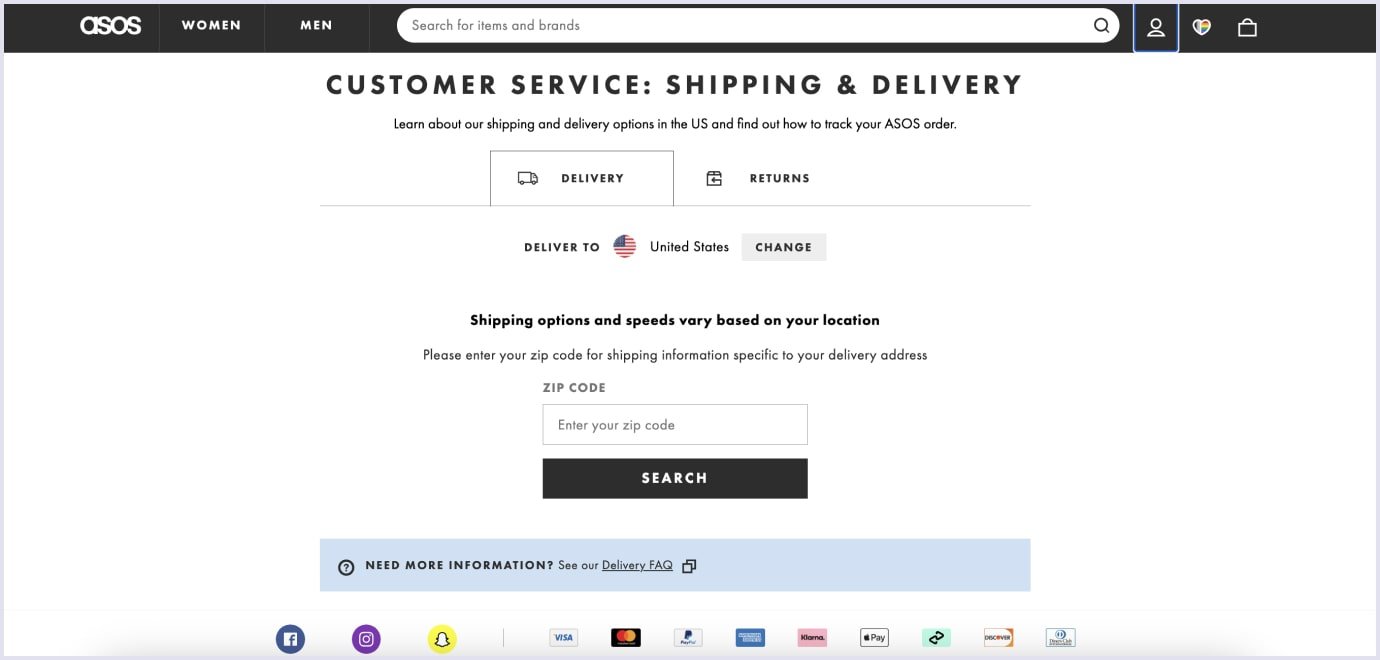
Source: Asos
Read also: Top 10 Shipping Integrations for Your Marketplace
This is functionality you should consider in the first place. With these features, you will get a convenient and easy-to-use marketplace.
2. Choose the development platform
When it comes to building a successful online marketplace, one of the most important decisions is choosing how you’ll develop it:
Will you use a ready-made solution or invest in a custom platform?
This choice directly impacts your scalability, speed to market, flexibility, and ultimately, your ability to stand out.
While off-the-shelf tools might seem appealing at first glance, especially if you’re short on time or budget, they rarely adapt well to unique business models or long-term growth. Custom development, on the other hand, gives you full control and freedom.
Here’s why it makes a difference:
- Tailored to your exact needs. From marketplace logic to user roles and payments, everything works how you want it to. No compromises.
- Scalable from day one. As you grow, your platform grows with you. Whether you're onboarding more sellers or expanding globally, the system adapts.
- Efficient in the long run. No paying for bloated features you don’t need. Your investment goes toward building only what brings value.
- Built for compliance and security. Especially crucial in regulated industries like fintech, edtech, or healthtech, where generic solutions often fall short.
- Brand differentiation. A unique UX and custom workflows help you stand out in a crowded marketplace space. Competitors can’t just copy-paste your success.
Of course, there are valid cases where a prebuilt platform works well:
- You need to launch fast to validate an idea or secure investment.
- Your business model is very simple or matches existing marketplace templates.
- Your budget is limited and you're okay with scaling constraints early on.
If you're just testing waters, off-the-shelf might be a great launchpad. But if you’re aiming to build something lasting, something flexible, scalable, and unmistakably yours, then custom marketplace development is the smarter, long-term path.
3. Select the right development team
Partnership with the proper development team is crucial for the successful marketplace launch. Therefore, you should choose the software provider responsibly.
The tips below will help you find a dedicated agency that will satisfy all your project needs.
- Visit research and rating platforms like Clutch, GoodFirms, Appfutura. They will provide you with detailed information about the team needed. You can read reviews of their existing clients on such websites.
- Make sure the team you have chosen knows how to launch a marketplace that brings value for both buyers and sellers.
- Pay attention to the organization of the development process and technology applied. At Codica, we use Ruby on Rails to build reliable and fast-loading solutions.
- Give preference to companies that adopted the agile methodology. This approach helps make alterations at any development stage. Besides, with the agile methodology you can respond faster and more effectively to the market demands. This way, you eliminate the risk of expensive market misses.
- Check the software company’s portfolio to make sure they will create user-friendly online marketplaces.
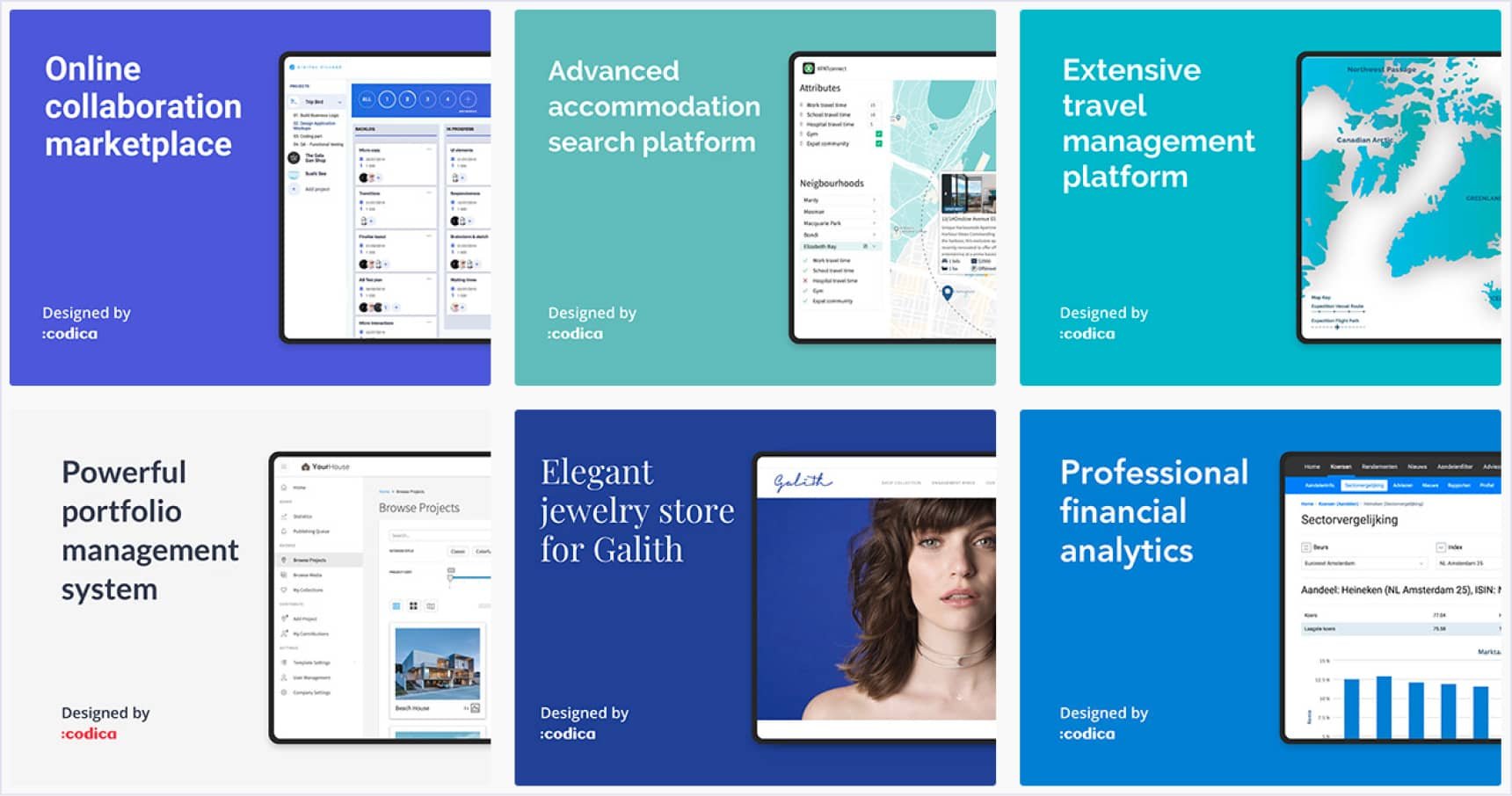
Starting a new project is rather a challenging process. To make things easier, choose an established team that knows how to launch a marketplace that is fast, scalable, and user-friendly.
4. Develop an MVP first
Building a Minimum Viable Product (MVP) lets you validate your marketplace idea without sinking time or money into unproven features. By focusing on core functionality first, you can get a working platform into users’ hands quickly, and learn what really matters to them.
Why start with an MVP?
- Faster launch. Release a lean version in weeks, not months, so you can attract early adopters before competitors do.
- Cost control. Spend only on essential features, avoiding wasted budget on bells and whistles that may never resonate.
- User-driven improvements. Real feedback from actual buyers and sellers highlights pain points and reveals must-have enhancements.
- Iterative growth. Use early insights to guide your roadmap, adding new features only when they deliver clear value.
Begin by mapping out your “must-have” features (see Step 1), then strip away everything else. Pilot your MVP with a small group of vendors and buyers, collect their input, and iterate fast. This lean approach transforms your marketplace concept into a product people love, and lays a solid foundation for scaling.
Related reading: How to Build a Marketplace Website MVP and Not Fail
5. Build trust for sellers and buyers
Don’t underestimate the importance of UX design. Pretty often it helps prove to your customers that it is completely safe to buy and sell products and services on your platform.
Do you want to know how to launch a marketplace that your customers will trust? Take into account the following points:
- High-quality photos and videos allow buyers to view items from different sides and angles. So, why not give sellers the opportunity to provide as many details as possible?
- A thorough product description gives customers comprehensive information about the desired item.
- Reviews and ratings show that customers can trust a vendor and the quality of its products.
- Refund policy is a must-have for an e-commerce platform. With this option, customers feel safer when purchasing.
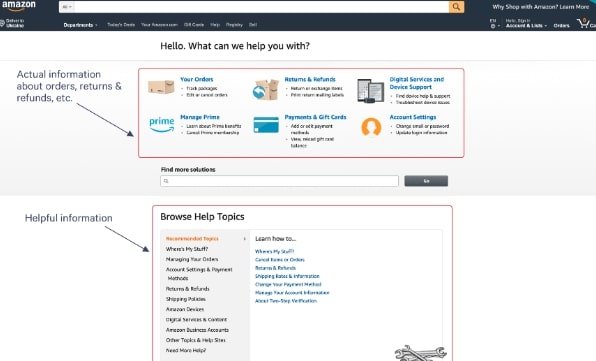
Source: Amazon
Focus on building a well-arranged and easy-to-navigate marketplace. Thus, you will offer a seamless user experience that will bring new customers to your platform.
6. Create a strong marketing strategy
We have discussed how to launch a marketplace. The next question is how you can promote your brand-new e-commerce platform.
An efficient marketing tactic helps attract both vendors and buyers to your online marketplace. Of course, solving the chicken and egg problem can be a bit effortful. Let potential customers know about your startup from the planning stage.
Use the following tips to gain sellers and buyers attention:
- Promote your platform via ads on social media, including Instagram, Facebook, and LinkedIn.
- Become a part of workshops or educational meetups. Attend these events to connect with your potential vendors and buyers.
- Visit trade fairs to search for sellers. Find a subtle way to get their contact information. Thus, you will be able to reach them afterward.
- Organize live events and collaborate with celebrities.
7. Find tools to monitor different aspects of your marketplace
To keep your marketplace humming, you need more than just code, you need a suite of tools that give you real-time insight, streamline collaboration, and help you respond quickly to both business and user needs. Here’s a modern stack to consider:
Traffic & user behavior:
- Google Analytics for high-level metrics: sessions, traffic sources, conversion funnels.
- Amplitude or Mixpanel for in-depth product analytics: track feature adoption, user paths, retention cohorts and A/B test results.
Customer relationship management:
- HubSpot CRM or Pipedrive to manage leads, track vendor outreach and automate email sequences. Their free tiers make them especially attractive for startups.
Knowledge base & collaboration:
- Notion or Confluence as your single source of truth. Combine specs, meeting notes, product roadmaps and SOPs in one searchable workspace.
Brand monitoring & social listening:
- Brand24 or Awario to catch every mention of your marketplace across news sites, forums and social media, so you can jump on feedback (or manage crises) right away.
Social media scheduling & reporting:
- Hootsuite or Later to plan, schedule and analyze posts across Instagram, Facebook and LinkedIn, keeping your promotional calendar on track while gathering engagement insights.
Session replay & UX insights:
- Hotjar or FullStory for heatmaps, click-maps and user session recordings. Spot confusing flows and optimize pages before they become conversion killers.
Customer support & feedback:
- Intercom or Zendesk to centralize support tickets, live chat and in-app messaging. Tie support requests back to user profiles for faster, more personalized service.
Project management & roadmapping:
- Jira or Trello to turn feature requests into actionable tasks, assign sprints and maintain a transparent product roadmap that your whole team can follow.
No single tool can do everything, but together, they give you the data, communication channels and operational structure needed to run a smooth, user-focused marketplace.

Summary
As Mark Twain once said, “The secret of getting ahead is getting started.”
Your marketplace idea deserves a strong start, and expert support. From MVP to full-scale development, Codica is ready to help you build something remarkable.
Over the years, we’ve brought numerous marketplace ideas to life, just take a look at our portfolio to see what we’ve achieved with our clients.
If you’re ready to bring your vision to life, don’t hesitate to get in touch with us. We’d love to hear about your project. Let’s build something great together!
